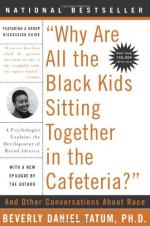
|
| Name: _________________________ | Period: ___________________ |
This test consists of 5 multiple choice questions, 5 short answer questions, and 10 short essay questions.
Multiple Choice Questions
1. In what year did the Mexican-American War end?
(a) 1855.
(b) 1857.
(c) 1862.
(d) 1848.
2. What is the second of five stages that whites pass through in dealing with race, according to the author in Part III, Understanding Whiteness in a White Context, Chapter 6, The Development of White Identity?
(a) Disintigration.
(b) Racism.
(c) Contact.
(d) Pseudo-independence.
3. Barack Obama was born in what year?
(a) 1969.
(b) 1973.
(c) 1944.
(d) 1961.
4. What term refers to the indigenous peoples in North America within the boundaries of the present-day continental United States, parts of Alaska, and the island state of Hawaii?
(a) Caucasian.
(b) Asian-Pacific American.
(c) Native Americans.
(d) Latino.
5. What refers to state and local laws in the United States enacted between 1876 and 1965 that mandated racial segregation in all public facilities?
(a) Jim Crow laws.
(b) White suprmecist laws.
(c) Segregation laws.
(d) Colored laws.
Short Answer Questions
1. What is the fourth of five stages that whites pass through in dealing with race, according to the author in Part III, Understanding Whiteness in a White Context, Chapter 6, The Development of White Identity?
2. What concept defined by the author holds the extended family as a reference group for social support?
3. What is the fifth of five stages that whites pass through in dealing with race, according to the author in Part III, Understanding Whiteness in a White Context, Chapter 6, The Development of White Identity?
4. What refers to the concept of individual or collective guilt often said to be felt by some white people for the racist treatment of people of color by whites both historically and presently?
5. Puerto Rico is Spanish for what phrase?
Short Essay Questions
1. How does Tatum suggest Whites find redefinition in racial identity in Part III, Understanding Whiteness in a White Context, Chapter 6, The Development of White Identity?
2. How is biracial development approached by the author in Part IV, Beyond Black and White, Chapter 9, Identity Development in Multiracial Families?
3. What is the author's conclusion about forming racial identity within minority groups in Part IV, Beyond Black and White, Chapter 8, Critical Issues in Latino, American Indian, and Asian Pacific American Identity Development?
4. How does the author describe the similarities and variations within the Native American community in Part IV, Beyond Black and White, Chapter 8, Critical Issues in Latino, American Indian, and Asian Pacific American Identity Development?
5. What misconception does the author attempt to clear away in Part IV, Beyond Black and White, Chapter 9, Identity Development in Multiracial Families?
6. In Part IV, Beyond Black and White, Chapter 8, Critical Issues in Latino, American Indian, and Asian Pacific American Identity Development, Tatum addresses what element as drawing together minorities?
7. How does Tatum describe the variations and similarities within the Latino community in Part IV, Beyond Black and White, Chapter 8, Critical Issues in Latino, American Indian, and Asian Pacific American Identity Development?
8. When and how does Tatum describe the need for racial consciousness in biracial children in Part IV, Beyond Black and White, Chapter 9, Identity Development in Multiracial Families?
9. What is the effect of white resistance to racism, according to the author in Part III, Understanding Whiteness in a White Context, Chapter 6, The Development of White Identity?
10. What stages of white identity development does the author describe in Part III, Understanding Whiteness in a White Context, Chapter 6, The Development of White Identity?
|
This section contains 1,041 words (approx. 4 pages at 300 words per page) |

|




